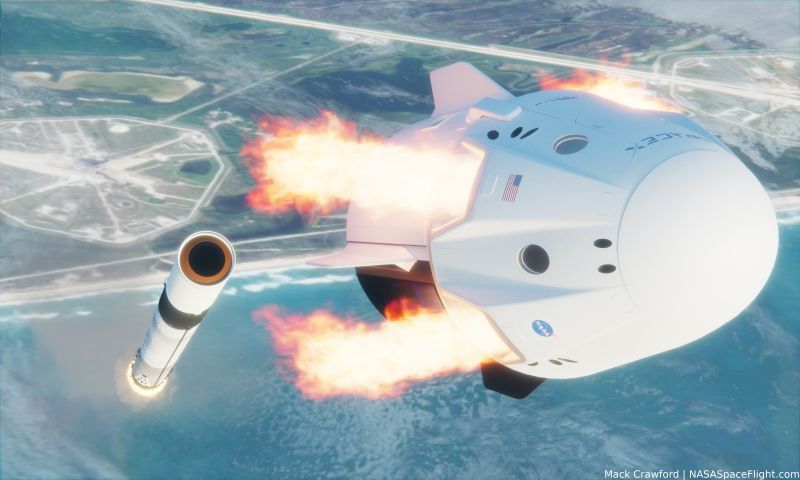 Реклама Google — средство выживания форумов :)
Реклама Google — средство выживания форумов :)
-
![[image]](https://www.balancer.ru/cache/sites/ru/le/lenta/icdn/images/2015/01/29/11/20150129111022058/128x128-crop/original_68c53871bed7cddaeb1db703d13f2eb8.jpg)
SpaceX
сейчас - о DragonТеги:
Spinch> https://www.nasaspaceflight.com/wp-content/uploads/2019/12/Dragon-2-IFA-july-2019-final.jpg
Ну, да, по слухам из NASA
Hearing that NASA and SpaceX are now targeting no earlier than Jan. 18 for Crew Dragon's Inflight Abort Test. Falcon 9 static fire set for as early as the end of this week.
— Michael Baylor (@nextspaceflight) January 6, 2020
📸 @brickmack for https://t.co/Ir91lYe7HShttps://t.co/eRbXUlgZEG pic.twitter.com/5TlEwQfOIP
B1046 4 is basking in the sun at LC-39A. Static fire ahead of the IFA test is expected tomorrow, January 10th. Viewed from Merritt Island Wildlife Refuge. #SpaceX #IFA pic.twitter.com/tfJMdUBlkq
— Julia (@julia_bergeron) January 9, 2020
Launch hazard area issued for 01/18 #SpaceX Crew Dragon in-flight abort test. In effect from 0600 to 1230 ET (1100 to 1730 UTC). Liftoff from KSC's pad 39A. pic.twitter.com/zLY8cvF93y
— Emre Kelly (@EmreKelly) January 9, 2020


Bopper (Baby StarPopper) this morning after the overpressure event at SpaceX Boca Chica. 🤩🚀@NASASpaceflight https://t.co/nCG7E9XtKM pic.twitter.com/PRTDQvvlRh
— Mary (@BocaChicaGal) January 10, 2020
Ответ:
Dome to barrel weld made it to 7.1 bar, which is pretty good as ~6 bar is needed for orbital flight. With more precise parts & better welding conditions, we should reach ~8.5 bar, which is the 1.4 factor of safety needed for crewed flight.
— Buff Mage (@elonmusk) January 10, 2020
Everyday Astronaut @Erdayastronaut·8 ч
6 bar is flight pressure?! That’s like double F9 right? So really the Starship has even more prop than I realized 🤯 that thing is a beast!
Buff Mage @elonmusk·4 ч
A given tank pressure is needed to feed the engine turbopumps & pressure-stabilize/relieve compression load on the cylinder walls
Buff Mage @elonmusk·4 ч
Everything is compressible, but liquid compression at these pressures is not significant. However, the tanks do expand under pressure, creating a bit more volume. Keeping propellant super cold has a big effect on density of ~10% in case of CH4.
Viv 🐉 @flcnhvy·4 ч
Will Starship SN1 use the same thickness of stainless steel as this pathfinder tank?
Buff Mage @elonmusk·1 ч
Yes


Полагаю, SpaceX угробят еще не менее пары баков, пока не определят удовлетворяющую их методику изготовления. Причем не просто проверят держит ли бак нужное давление, а именно с финальным доведением до разрушения - так проще всего найти слабое место/места конструкции.


Watch a SpaceX rocket blow up during abort test
SpaceX's Dragon Crew Capsule safely blasted away from its carrier Falcon rocket in an test of its abort systems on Jan 19, 2020. The rocket exploded during descent as expected: https://www.space.com/spacex-crew-dragon-launch-abort-test-success.html Credit: SpaceX


Crew Dragon separating from Falcon 9 during today’s test, which verified the spacecraft’s ability to carry astronauts to safety in the unlikely event of an emergency on ascent pic.twitter.com/rxUDPFD0v5
— SpaceX (@SpaceX) January 19, 2020


А зачем они ПОТОМ ракету взорвали? Совсем по честному - надо было рвать до отделения и не на столь высокой скорости.


Naib> А зачем они ПОТОМ ракету взорвали? Совсем по честному - надо было рвать до отделения и не на столь высокой скорости.
Небось её никто и не взрывал. Просто потеряла стабильность без тяги и разрушилась от набегающего потока.


Naib> А зачем они ПОТОМ ракету взорвали? Совсем по честному - надо было рвать до отделения и не на столь высокой скорости.
Они не взрывали. По описанию спейсексов, САС сработала автоматически после того, как по команде была снижена тяга двигателей первой ступени, и система контроля посчитала ситуацию аварийной, как и было запланировано. Так как Дракон служит ракете головным обтекателем, ракету после его потери разорвало набегающим потоком воздуха, а вторая ступень была полностью заправлена, отсюда и взрыв.


Таки может у меня паранойя, но взрыв шёл от нижнего блока двигателей, а верхняя ступень не хлопнула. По крайней мере, заливать в неё керосин смысла не было. Да и двигатель ставить в общем-то...
И в системе САС появляется дыра на момент сброса первой ступени, когда подобный протокол должен быть заблокирован.
Кроме того, САС по прежнему уводит корабль очень медленно.


А что с ней ещё делать, раз не развалилась?
Вторая ступень кстати так целая и упала. И даже взрыв ей похрен оказался. А кораблю тем более.
Naib> Совсем по честному - надо было рвать до отделения и не на столь высокой скорости.
Посчитали что лучше испытывать на MaxQ
Naib> По крайней мере, заливать в неё керосин смысла не было.
Пустой ставить никак - режим полёта, как бы. А заливать что-то другое труб на вышке нет.
А движок и не ставили. Как и прочие мелочи.
Naib> Кроме того, САС по прежнему уводит корабль очень медленно.
А оно надо, быстрее?


Я, видимо, недостаточно жирно написал слово "потом". Для проверки САС в максимально жёстких условиях нужно было взорвать первую ступень до отделения корабля и в момент максимального аэродинамического сопротивления.
Naib>> Кроме того, САС по прежнему уводит корабль очень медленно.
Дем> А оно надо, быстрее?
Конечно. Первые 2 секунды САС вообще увести корабль не может. Лишь на 3 секунде удаётся "уйти в отрыв", причём скорее из-за торможения ступени, чем тяги собственных двигателей. В общем, "низачот". В условиях взрыва ступени САС корабль не спасёт.


Нет, наиболее жёстко - это пытаться убежать от работающей ступени. Особенно на завершающем этапе
Naib> Конечно. Первые 2 секунды САС вообще увести корабль не может.
Движки дают где-то 5-6 же, так что это обманчиво что не может.
Naib> В условиях взрыва ступени САС корабль не спасёт.
В условиях взрыва ступени - не пострадала даже вторая ступень.


Тем более не убежит.
Дем> Движки дают где-то 5-6 же, так что это обманчиво что не может.
А ты посмотри ролик по секундам. В лучшем случае 3 же они дают.
Дем> В условиях взрыва ступени - не пострадала даже вторая ступень.
Потому что взрыв был на максимальном удалении и ступень не заправлена. Не всегда так везёт.


а надо? вот союз взорвался, и только потом сработала САС.
сам КК тоже крепкий.


s.t.> а надо? вот союз взорвался, и только потом сработала САС.
Не взорвался. Загорелся. Взорвался он уже после того, как САС увела корабль.
s.t.> сам КК тоже крепкий.
САС у Союза выдаёт под 20 "же".


это я знаю, но из условий нерасчетного входа и термических нагрузок, а также удара при посадке капсулы должны быть прочными? Что союз, что дракон, примерно одинаково. Т.е. насколько возможно нанесение больших повреждений при любом сценарии и высоте?


Полл> Он же их выдает на старте, пока "башня" не сброшена?
Так "башня" сбрасывается перед самым концом работы первой ступени, на 114-й секунде, а боковушки - на 118-й. И всё это время САС может выдать под 20 "же". Ну, на max Q выйдет поменьше, из-за сопротивления воздуха, но, всё равно, больше 12 "же". Но и дальше на обтекателе есть 4 РДТТ, которые, хоть и не столь могучи, но, примерно, как "супердрако" в этом эпизоде. Они и сработали при аварии Союза-МС-10. Они могут сработать до 153-й секунды. А, вот, уже ещё дальше, могут работать только двигатели самого корабля. Логика их срабатывания мне в точности неизвестна, но при аварии Союз-18-1 с Лазаревым и Макаровым, они не вмешивались, т.к. авария была сравнительно "мягкой", ДУ работала нормально, но ракета не смогла "удержаться" в 7-градусном "коридоре" из-за поломки замков хвостового отсека 3-й ступени.


s.t.> это я знаю, но из условий нерасчетного входа и термических нагрузок, а также удара при посадке капсулы должны быть прочными?
Нет, капсула рассчитывается на "стандартный" баллистический спуск, с некоторым запасом, но не на любой "нерасчётный" вход. Это невозможно. Условно говоря, если будет сто "же", и капсула их выдержит, а люди внутри - нет, нафига ей быть целой?
s.t.> Что союз, что дракон, примерно одинаково.
Тоже нет, ибо у них разные парашютные системы и разные системы мягкой посадки. Что там у Дракона с посадкой на сушу? Старлайнер садится на надувные подушки...
s.t.> Т.е. насколько возможно нанесение больших повреждений при любом сценарии и высоте?
Если взрывается ДУ третьей ступени, подобно тому, как это было на "Прогрессе-М27-М", то корабль остаётся цел - ну, достаточно цел, чтобы ничего не случилось с космонавтами. В основном, потому, что нечему проводить ударную волну. Хотя отсек сухих грузов "Прогресса" менее прочен, чем СА.
Известно, что 3,2 атмосферы СА "Союза" не выдерживает, лопается.


 Реклама Google — средство выживания форумов :)
Реклама Google — средство выживания форумов :)
Должен!
Naib> А ты посмотри ролик по секундам. В лучшем случае 3 же они дают.
вот скачал, смотрю:
2 кадр - появляется рыжий дым из движков
7 - факел
20 - полностью гаснут движки ступени
40 - КК отошёл примерно на свой размер
60 - примерно на четыре размера
100 - примерно на длину ракеты (1+2 ступень)
Naib> Потому что взрыв был на максимальном удалении и ступень не заправлена. Не всегда так везёт.
Ступень - заправлена. Но в прошлый раз, когда вторая ступень рванула - корабль не пострадал. Хотя разбился, потому что переход в режим посадки не был предусмотрен.


Создано 26.11.2005
Связь с владельцами и администрацией сайта: anonisimov@gmail.com, rwasp1957@yandex.ru и admin@balancer.ru.
 Spinch
Spinch


 инфо
инфо инструменты
инструменты Alexandrc
Alexandrc

 FarEcho
FarEcho


 Naib
Naib
 zaitcev
zaitcev

 Tico
Tico





